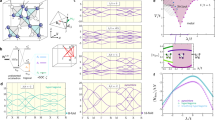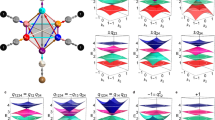Abstract
Band insulators appear in a crystalline system only when the filling—the number of electrons per unit cell and spin projection—is an integer. At fractional filling, an insulating phase that preserves all symmetries is a Mott insulator; that is, it is either gapless or, if gapped, exhibits fractionalized excitations and topological order. We raise the inverse question—at an integer filling is a band insulator always possible? Here we show that lattice symmetries may forbid a band insulator even at certain integer fillings, if the crystal is non-symmorphic—a property shared by most three-dimensional crystal structures. In these cases, one may infer the existence of topological order if the ground state is gapped and fully symmetric. This is demonstrated using a non-perturbative flux-threading argument, which has immediate applications to quantum spin systems and bosonic insulators in addition to electronic band structures in the absence of spin–orbit interactions.
This is a preview of subscription content, access via your institution
Access options



Similar content being viewed by others
References
Hastings, M. B. Lieb–Schultz–Mattis in higher dimensions. Phys. Rev. B 69, 104431 (2004).
Hastings, M. B. Sufficient conditions for topological order in insulators. Europhys. Lett. 70, 824–830 (2005).
Oshikawa, M. Commensurability, excitation gap, and topology in quantum many-particle systems on a periodic lattice. Phys. Rev. Lett. 84, 1535–1538 (2000).
Lieb, E., Schultz, T. & Mattis, D. Two soluble models of an antiferromagnetic chain. Ann. Phys. 16, 407–466 (1961).
Altman, E. & Auerbach, A. Haldane gap and fractional oscillations in gated Josephson arrays. Phys. Rev. Lett. 81, 4484–4487 (1998).
Oshikawa, M., Yamanaka, M. & Affleck, I. Magnetization plateaus in spin chains: Haldane gap for half-integer spins. Phys. Rev. Lett. 78, 1984–1987 (1997).
Yao, H. & Kivelson, S. A. Fragile Mott insulators. Phys. Rev. Lett. 105, 166402 (2010).
Kimchi, I., Parameswaran, S. A., Turner, A. M. & Vishwanath, A. Featureless and non-fractionalized Bose insulator on the honeycomb lattice at 1/2 site-filling. Preprint at http://arxiv.org/abs/1207.0498 (2012).
Yablonovitch, E. Inhibited spontaneous emission in solid-state physics and electronics. Phys. Rev. Lett. 58, 2059–2062 (1987).
John, S. Strong localization of photons in certain disordered dielectric superlattices. Phys. Rev. Lett. 58, 2486–2489 (1987).
Herring, C. Character tables for two space groups. J. Frankl. Inst. 233, 525–543 (1942).
Herring, C. Effect of time-reversal symmetry on energy bands of crystals. Phys. Rev. 52, 361–365 (1937).
König, A. & Mermin, N. D. Electronic level degeneracy in nonsymmorphic periodic or aperiodic crystals. Phys. Rev. B 56, 13607–13610 (1997).
Michel, L. & Zak, J. Connectivity of energy bands in crystals. Phys. Rev. B 59, 5998–6001 (1999).
Shastry, B. S. & Sutherland, B. Exact ground state of a quantum-mechanical antiferromagnet. Physica 108B, 1069–1070 (1981).
Sebastian, S. E. et al. Fractalization drives crystalline states in a frustrated spin system. Proc. Natl Acad. Sci. USA 105, 20157–20160 (2008).
Jaime, M. et al. Magnetostriction and magnetic texture to 100.75 Tesla in frustrated SrCu2(BO3)2 . Proc. Natl Acad. Sci. USA 109, 12404–12407 (2012).
König, A. & Mermin, N. D. Screw rotations and glide mirrors: Crystallography in Fourier space. Proc. Natl Acad. Sci. USA 96, 3502–3506 (1999).
Oshikawa, M. Insulator, conductor, and commensurability: A topological approach. Phys. Rev. Lett. 90, 236401 (2003).
Paramekanti, A. & Vishwanath, A. Extending Luttinger’s theorem to Z2 fractionalized phases of matter. Phys. Rev. B 70, 245118 (2004).
Onizuka, K. et al. 1/3 magnetization plateau in SrCu2(BO3)2—stripe order of excited triplets. J. Phys. Soc. Jpn 69, 1016–1018 (2000).
Kodama, K. et al. Magnetic superstructure in the two-dimensional quantum antiferromagnet SrCu2(BO3)2 . Science 298, 395–399 (2002).
Abendschein, A. & Capponi, S. Effective theory of magnetization plateaux in the Shastry–Sutherland lattice. Phys. Rev. Lett. 101, 227201 (2008).
Dorier, J., Schmidt, K. P. & Mila, F. Theory of magnetization plateaux in the Shastry–Sutherland model. Phys. Rev. Lett. 101, 250402 (2008).
Momoi, T. & Totsuka, K. Magnetization plateaus of the Shastry–Sutherland model for SrCu2(BO3)2: Spin-density wave, supersolid, and bound states. Phys. Rev. B 62, 15067–15078 (2000).
Balents, L., Fisher, M. P. A. & Girvin, S. M. Fractionalization in an easy-axis Kagome antiferromagnet. Phys. Rev. B 65, 224412–224419 (2002).
Roy, R. Space group symmetries and low lying excitations of many-body systems at integer fillings. Preprint at http://arxiv.org/abs/1212.2944 (2012).
Acknowledgements
We thank I. Kimchi and D. Stamper-Kurn for collaboration on related work, R. Roy for many detailed conversations, M. Hermele, M. Oshikawa, S. Coh and M. Zaletel for stimulating discussions and M. Norman for valuable comments on the manuscript. This work is supported by the Simons Foundation (S.A.P. and A.V.) and by the National Science Foundation Grants No. 1066293 at the Aspen Center for Physics (S.A.P., D.P.A., A.V.), PHY11-25915 through the Frustrated Magnets programme at the Kavli Institute for Theoretical Physics (S.A.P., A.V.), DMR-1007028 (D.P.A.) and DMR-1206728 (A.V.).
Author information
Authors and Affiliations
Contributions
The research reported here emerged from lively discussions between the authors. All authors contributed to writing the manuscript.
Corresponding author
Ethics declarations
Competing interests
The authors declare no competing financial interests.
Supplementary information
Supplementary Information
Supplementary Information (PDF 307 kb)
Rights and permissions
About this article
Cite this article
Parameswaran, S., Turner, A., Arovas, D. et al. Topological order and absence of band insulators at integer filling in non-symmorphic crystals. Nature Phys 9, 299–303 (2013). https://doi.org/10.1038/nphys2600
Received:
Accepted:
Published:
Issue Date:
DOI: https://doi.org/10.1038/nphys2600
This article is cited by
-
Magnetic and electronic properties unveil polaron formation in Eu\(_5\)In\(_2\)Sb\(_6\)
Scientific Reports (2023)
-
Computation and data driven discovery of topological phononic materials
Nature Communications (2021)
-
Chirality-driven topological electronic structure of DNA-like materials
Nature Materials (2021)
-
General Lieb–Schultz–Mattis Type Theorems for Quantum Spin Chains
Communications in Mathematical Physics (2021)
-
Colossal magnetoresistance in a nonsymmorphic antiferromagnetic insulator
npj Quantum Materials (2020)



